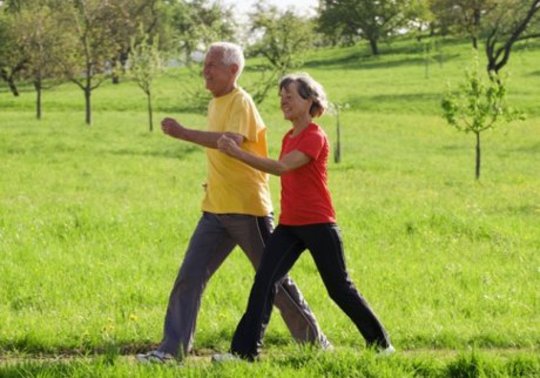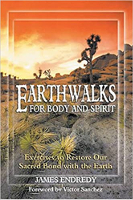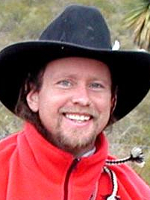
For most people walking is an activity that requires no thought or intention -- because we have done it almost our whole lives, it is rarely even a conscious action. What's more, since walking is such a natural act, we are able to involve ourselves in a host of other activities while doing it. Because we most often walk to get from one place to the next, it is quite common for us to talk, eat, think, or even read while walking. Because of this, we seldom pay any attention to how we walk or to how the people around us walk. But watching other people walk is one of the best ways to discover who they are and can also provide you with clues to how you yourself walk.
This observation of other people starts as an exercise but can evolve into an important tool. Understanding how walking reflects the inner being of the walker is a valuable skill for interacting in the world. To begin your observation, place yourself in a position where you can observe lots of people walking. Notice the variety of physical walking styles and pay attention to any patterns that arise.
Does someone with an angry scowl usually walk fast or slow? How is a child's walk different from an adult's? Do females walk differently from males? How do body position and balance affect a person's walk -- is a person's head leaning forward or is it straight, is the body leaning into the direction of motion or away from it, is the stride short and rapid or long and slow?
Although people walk in a variety of ways, there are some universal aspects to most people's walking that stem from our lives in the modern world and reflect the inner attitudes that are so often produced by an industrialized culture. For instance, many people experience wandering attention when they walk, a result of time spent in a world that requires us to think about many things at the same time. Most people walk with their bodies moving willy-nilly, their centers of gravity and balance shifting uncontrollably.
Walking with intention is a valuable technique to enjoy and use throughout life, reflecting a proactive state of being and attitude toward the future. It can help build strength and confidence to meet the world in a way that is as fluid as the water in a flowing river rather than as stop-and-start as a car stuck in a traffic jam. This state of being can be applied to all aspects of life and can spread from you to all those around you.
Creating a Sacred Space
Performing Earthwalks will naturally lead to periods of time in which you take yourself out of your normal environment and state of being. While these times can be special and magical respites from the demands of modern life, they should be viewed as more than merely mini-vacations or rest breaks. These walks are best performed when you begin them with the intention of learning something about yourself and the world around you. Performing them can be viewed as walking the path of knowledge or as walking sacred ground, suggesting the importance of your practice.
It will be beneficial to arrive at the starting place of your walk in a state of being that is intentional and planned. You should begin each walk in a state that will allow you to perform with a minimum of distracting thoughts about your day. In most cases, it is best to make a conscious effort to take care of whatever you need to do before going for your walk -- getting the affairs of your day in order, making sure you have time allocated for the exercise so that you are not worrying about eating, going to the bathroom, getting something into the mail, and so on.
Creating this kind of time for yourself has many advantages in terms of performing the walks and raising your quality of life. Walking outdoors, reflecting, and exercising are activities that are commonly robbed from us by today's fast-paced, time-starved world.
Walking Safely
You must remain responsible for your own safety at all times while walking. If you are walking in an unfamiliar area, make sure ahead of time that it is a safe place to travel in solitude and understand that you will need to be even more aware of your surroundings in order not to get lost, fall on uneven ground, or travel into territory where people might be hunting, for example.
The main rule is simply to use common sense. Dress appropriately for the season, wear comfortable shoes, and don't walk near dangerous areas such as quarries and landfills or in areas that are known as magnets for illegal activity. Be especially aware if you are traveling alone in an area removed from other people or if darkness is approaching -- especially if you are a woman. It's a sad fact in our modern society that women in particular are not always safe from harm in Nature's quiet and removed places.
If you are new to walking long distances, keep your walks short until you build endurance. If you take medication for any type of serious illness, don't go walking without it. Listen to your body -- it can communicate both positive and negative conditions, and remember that not all of these are caused by the obvious.
Weariness may not be related to the way you walk or the distance you walk so much as to your diet or the way you deal with stress. Though I have easily climbed tall mountains during a long fast, I have also taken walks during which I felt tired after only a few steps because I was carrying a big load of sadness or self-pity on my back. The point is that many things contribute to physical performance; it's important to build awareness of the relationship you have with your body and practice common sense while you perform your Earthwalks.
Reprinted with permission of the publisher, Bear & Co.,
a division of Inner Traditions International. ©2002.
www.innertraditions.com
Article Source:
Earthwalks For Body and Spirit
by James Endredy.
 In Earthwalks for Body and Spirit, a workbook of 45 simple walking exercises, author and workshop leader James Endredy shows us how the act of walking can be a catalyst for personal transformation by teaching us to develop our attention, quiet the mind, expand our consciousness, and rediscover our sacred relationship with Earth. Each of the exercises, many of which are based on the author's work with the traditional indigenous practices of the Huichol Indians of western Mexico, offers step-by-step instructions and comments that will help you to gain the most from the walk. Additionally, the author focuses each group of exercises on a different aspect of transformation
In Earthwalks for Body and Spirit, a workbook of 45 simple walking exercises, author and workshop leader James Endredy shows us how the act of walking can be a catalyst for personal transformation by teaching us to develop our attention, quiet the mind, expand our consciousness, and rediscover our sacred relationship with Earth. Each of the exercises, many of which are based on the author's work with the traditional indigenous practices of the Huichol Indians of western Mexico, offers step-by-step instructions and comments that will help you to gain the most from the walk. Additionally, the author focuses each group of exercises on a different aspect of transformation
Info/Order this book. Also available as a Kindle edition.
About the Author
 James Endredy is a teacher, mentor, and guide to thousands of people through his books and workshops. After a series of life tragedies and mystical experiences as a teenager he changed direction from his Catholic upbringing and embarked on a life-long spiritual journey to encounter the mysteries of life and death and why we are all here. For over twenty-five years he has learned shamanic practices from all over the globe, while also studying with kawiteros, lamas, siddhas, roadmen, and leaders in the modern fields of ecopsychology, bioregionalism, and sustainable living. James also worked for ten years with Mexican shamanic researcher Victor Sanchez learning to share shamanic practices with modern people.
James Endredy is a teacher, mentor, and guide to thousands of people through his books and workshops. After a series of life tragedies and mystical experiences as a teenager he changed direction from his Catholic upbringing and embarked on a life-long spiritual journey to encounter the mysteries of life and death and why we are all here. For over twenty-five years he has learned shamanic practices from all over the globe, while also studying with kawiteros, lamas, siddhas, roadmen, and leaders in the modern fields of ecopsychology, bioregionalism, and sustainable living. James also worked for ten years with Mexican shamanic researcher Victor Sanchez learning to share shamanic practices with modern people.
James leads workshops throughout the United States, Mexico, and Canada and is actively involved in preserving the world's indigenous cultures and traditional sacred sites, such as those of the Huichol Indians of western Mexico.
Visit his website at www.JamesEndredy.com


























